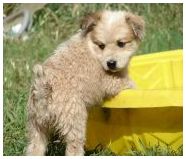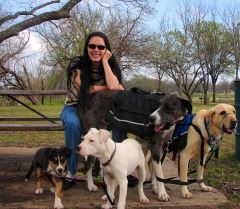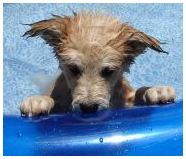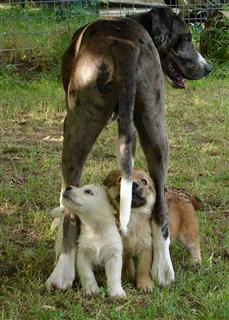Why an excited Dog is NOT cute
Dogs that greet their owners in this way are trying to communicate. But rather than professing undying love, they are trying to tell you that they are lonely and bored and that their needs as a dog are not being met. The excitement that you see is your dog’s way of burning off the excess energy that has been building throughout the day. The dog may also develop separation anxiety (see below).
People shouldn’t be disappointed by this revelation. This just means that dogs don’t use emotions like people do.
Remember, they’re dogs. To love a dog means you must treat him like an animal, which means fulfilling him as Nature intended him to be fulfilled.
Now, let’s get back to our barking dog. So-called nuisance barking, which is often ongoing and not in response to a particular stimulus like a jogger running by the house, is your dog’s way of sending you a distress signal.
Somewhere his needs as an animal are not being met. Is his world anchored by a pack leader who projects calm-assertive energy? Are you walking with him every day, which exercises his body and his mind? Is he living a balanced life?
If nuisance barking is a problem, consider these issues to find a solution. It’s the best way to show real love for your dog.
If your dog jumps on you when you arrive home, she's the pack leader.
How can you tell if your dog is the pack leader?
It’s simple: If she jumps on you when you arrive home, she is the pack leader. If she jumps on your guests, she is making sure that these new arrivals also know she is in charge.
What can you do to stop this unwanted behavior? Most importantly, you need to establish yourself as pack leader. When a dog doesn’t have a clear pack leader who projects calm- assertive energy, she tries to fill the vacant role, usually to disastrous results (for the owner and for the dog).
Set Some Rules For You and Your Dog
Don’t shower your dog with affection when you walk through the door. This kind of attention is wonderful for a human child, but not for a dog. Remember dogs are animals, and the kindest thing you can do is to treat your dog like a dog by communicating in a way he’ll understand.
|
The dog's mom, the ultimate pack leader, would never tolerate inappropriate activity.
If she sees something she doesn't like, she stops the activity by moving the puppy out of the way in her calm-assertive manner.
The puppy learns an important boundary from the lesson, and her firm and unambiguous leadership balances the puppy's submissive role in the pack. |
 |
When your guests arrive, ask your dog to sit patiently. Your dog will follow your commands when he respects you as his pack leader. Remember, the animal pack leader doesn’t negotiate to get what he or she wants. The pack leader leads by projecting a calm-assertive energy, the language dogs use to communicate. |
The most important thing to remember is that you can’t be a leader only some of the time. Leadership is forever; inconsistency triggers confusion and anxiety in a dog. Animal pack leaders never waver from their leadership role, and neither should you.
Walking exercises your dog's body and stimulates your dog’s mind.
Dog moms teach their puppies a lot during their first few days and weeks of life. They set rules, boundaries and limitations and serve as the first pack leader of the puppy’s life. They also walk with their puppies, which is an important primal activity for dogs.
In their natural habitat, dogs earn food and water by walking and they get to experience the world. If a dog does not walk, she does not eat. You can see how this activity exists deep within a dog’s DNA, but too few dog owners recognize its importance.
Walking also exercises your dog’s body and stimulates her mind. It also provides a good opportunity for you to establish yourself as pack leader.
Walk the Walk
I walk about ten dogs at a time, sometimes off-leash if I’m in a safe area. People are amazed by this, but it’s simple: the dogs see me as their pack leader. This is why they follow me wherever I go.
Walking in front of a dog allows you to be seen as the pack leader because position matters to a dog. Conversely, if your dog controls you on the walk, he’s the pack leader. Master the walk, and your dog will relate to you as the pack leader and accept his submissive role within the pack. |
 |
Remember, most dogs are born into the submissive role and like it just fine. The problem starts when naturally submissive dogs try to fill what they see as a vacant pack leader role. Since Nature never intended them to take on this role, bad or unwanted behavior ensues as they act out or try to normalize their world.
During the walk you may feel the highest level of connection with your dog.Many dog owners believe their dogs only crave love and affection and treats. Not so. Dogs crave rules, boundaries and limitations from their pack leader. They also crave walking, a primal activity that they live to enjoy.
Dogs become aggressive out of frustration and dominance.
Any breed can cause trouble, but the bigger breeds can create bigger damage. This is where I find a lot of what I call my red-zone cases.
Its important to recognize the power of a strong breed like the pit bull and the Mastiffs. These dogs are very powerful and can destroy anything in an instant.
Remember that these dogs don’t dream of being in the news when they grow up. Dogs don’t premeditate bad acts like people do. Bad things happen when powerful breeds (or mixes of powerful breeds) live with humans who like the breed but don’t understand the animal in the dog.
In a larger breed, frustration will intensify what the animal can do. Many people consider the look or popularity of a breed before thinking about whether the dog works for their lifestyle. This is a recipe for disaster.
Wanted: Leadership
To control a powerful breed you need to become the dog’s pack leader and establish rules, boundaries and limitations. You need to fulfill the dog as Nature intended him to be fulfilled.
Dogs become aggressive out of frustration and dominance. The frustration comes from a lack of exercise, and the dominance comes from a lack of calm-assertive leadership.
Separation Anxiety
Simulated vs. true dog separation anxiety
There is true separation anxiety, and there is simulated separation anxiety, in which the dog behavior appears to be separation anxiety but it is, in fact, a learned behavior.
Simulated separation anxiety is often manifested when the dog lacks leadership as well as self-control. True separation anxiety, on the other hand, causes the dog to experience real stress during the absence of his owner.
In simulated separation anxiety, the dog knows that he will get attention if he acts badly. For some dogs, even being verbally reprimanded for such behavior is rewarding because he feels he was noticed.
Negative attention can be a reward in many cases, if the owner is unaware that certain needs of his dog are not being met. In these cases, there is little real stress involved, just misbehavior.
Simulated separation anxiety is fairly easy to overcome with a gradual approach, slowly increasing the amount of time spent in a crate—when you are at home as well as away—consistent obedience training, proper amounts of exercise, and strong leadership.
Severe cases of true separation anxiety impose a challenge to Pack Leaders.
Causes of dog separation anxiety
Dog separation anxiety is often unknowingly encouraged by dog owners. We make a big fuss when we leave or come home, and in doing so we reward the dog’s concern with our absence, provoking in him even more stress every time we leave.
We like our dogs to be with us and when they are puppies, we take them everywhere for socialization. Then, we have to leave them alone, but they reach an age when they not only want, but also feel the need to be with us—we are their source of confidence, their security, and their pack.
A change in their routines can create the symptoms of dog separation anxiety, but destruction and stress can also be created by boredom and lack of exercise. Terriers are born to dig, retrievers to carry and protection breeds to protect. So, in some instances we are holding them back from their instincts and drives, rather than nurturing them.
A good start to correct these problems: exercise, discipline, and only then, affection. You need to establish a balance between patience, obedience, and confidence in your dog.
Aim to develop a behavior in our dog that reflects the harmonious partnership you both share. He should have enough confidence in himself and in your leadership. This way, he can be confident in situations, such as being left alone, because he knows that you will always provide the leadership and guidance required. He trusts and knows that you will come home.
How to prevent dog separation anxiety
Vets may prescribe drugs, which tend to calm a dog’s senses a little, but they are not a cure. Drugs only provide a support mechanism to assist the owner in rehabilitating the dog, it is only a temporary fix for the underlying problem. You have to treat the root cause.
It really starts the moment you get your puppy. All too often a puppy taken from the litter begins to cry when left alone. This is a big change for the pup, they no longer have the pack they were born with. When he cries, we go and pick him up and show sympathy—his crying is rewarded. Later, if he is crying in a crate, and you let him out he is being rewarded for his crying. Only reward desired behavior.
From the beginning, we need to teach our pup to be quiet and settle down for increasing periods of time. We need to teach patience and calmness and reward that instead. When he is out with us, we should not be attempting to constantly interact with him. Let him learn to entertain himself with his toys.
Teach the pup to accept the crate. Allow him to explore under supervision and to learn the limits and boundaries of his environment; to gain respect for this environment, and for the people in it. That means consistency in all the things you do, and that includes everyone in the family who interacts with your dog.
The importance of obedience training and discipline
I believe much of the cure for separation anxiety comes from obedience training and discipline. This approach lets your dog know what is expected of him, helping his good behavior to become a habit. He feels wrong showing an unwanted behavior even without you indicating it. Take advantage of that.
Spend time training—not just classes once a week—often and consistently. Show your dog what you want from him in and around the house, and during daily routines. Two minutes here, five minutes there. Not just going for a walk but training him as you go to sit at curbsides, and sit when meeting others, people and dogs.
Teach your dog to sit at the door, lie down, and stay while you go out of sight for increasing periods of time in your own house. Train your dog to sit and wait to be greeted by guests, move aside when you go to the refrigerator, and go to the bathroom on cue. In general, you should be teaching your dog in small steps to be a respectful and have confidence in himself.
Rehabilitation begins by having your dog know what is expected of him. You and other members of your family are the pack leaders, and you need to be recognized as such, not as dictators, but as leaders. For example, if your dog comes up to you and nudges your hand, or slaps you with his paw. You think this is cute and he is petted. This becomes a habit, and now your dog thinks “I am in control and I can tell you what to do.” Then, when he cannot carry it out, he becomes stressed.
Crate training to avoid dog separation anxiety
When you are home, have your dog familiar with being in the crate. Start with short periods and then increase the time he spends in it. Feed him in the crate, let him have his favorite bone to be used as a stress reliever while he is in there.
Some toys are developed to entertain, or occupy your dog when you leave. I prefer to use such interactive toys only when I am present. These work because your dog’s mind is stimulated while attempting to remove treats from a toy, which then relaxes his mind, and he sleeps.
Do not put water in the crate—that can get very messy! The crate should be your dog’s safe haven, a place he feels secure and enjoys. It should be big enough for him to stand upright without his head touching the top, and he should be able to turn around and lay down easily.
If he barks in the crate, look for ways to control that. Teaching him “quiet” is good, and interrupting the barking so he learns there is no reward from it also works. In extreme cases, a good bark collar can help control the dog's barking in your absence. No one wants annoyed neighbors, and this device will correct him when you are not there.
When you leave him, do so quietly and don’t provide cues. Do not say anything. Go through your leaving routine quietly, pick up car keys, open garage doors, and start the car. Then, come back inside paying no attention to your dog. Do what you always do when leaving—role-play if it helps.
Come back in your home once more, and pay no attention to your dog. Walk past him, wave and smile if he is quiet but if he is banging at the crate, ignore it and walk away.
Come back and wait until he is quiet, and then ask him to wait in the crate while you open the door. He should not come bursting out. If you feel one action, such as putting on a certain pair of shoes, picking up your car keys, going to a certain door, brings about the beginning of stress, then do that action and do not leave. Get him so familiar with the action that he accepts it.
Place a cage-type crate in the busiest room in the house. The goal is for your dog to accept all the normal every-day movements, noises, and happenings within your home. Your dog must realize it is not necessary for him to be involved in everything because you are the one in charge.
You can always have more than one crate if, for example, you want your pal to sleep in the bedroom next to your bed. Covering the crate with a sheet when you leave gives the feeling of a den and your dog may like the crate better this way.
All of my dogs enjoy music and the TV, so I leave it on for them. It provides a familiar background sound and sight for them giving them a feeling of security.
Change your routine
It is possible for your dog to recognize a series of actions, you have to be clever. Changing your dog’s habits often means changing your own and that can be difficult—we are creatures of habit—but you’ll have to change your routine.
Use a different door, put your coat and bag in different places. Make changes to create a different picture. If you are watching TV, or working on the computer, and your dog gets up every time you get up, simply get up and sit down again.
Your dog does not have to follow you everywhere. Yes, he can watch but he should be able to wait until you request his company. These little changes will help teach your dog to have the self-confidence he needs to handle being alone.
Separation anxiety can be overcome, you can turn some dogs around fairly quickly, with others it takes time, patience, and consistency.
Exercise, obedience, and lifestyle training; leadership; rules, boundaries, and limitations, all of these are necessary for a balanced dog. Consistency from you and from every human in your household will be also crucial to build your dog’s confidence in you as his Pack Leader, and also in himself.
By Martin Deeley
References:
Martin Deeley
Cesar Millan Inc
|




